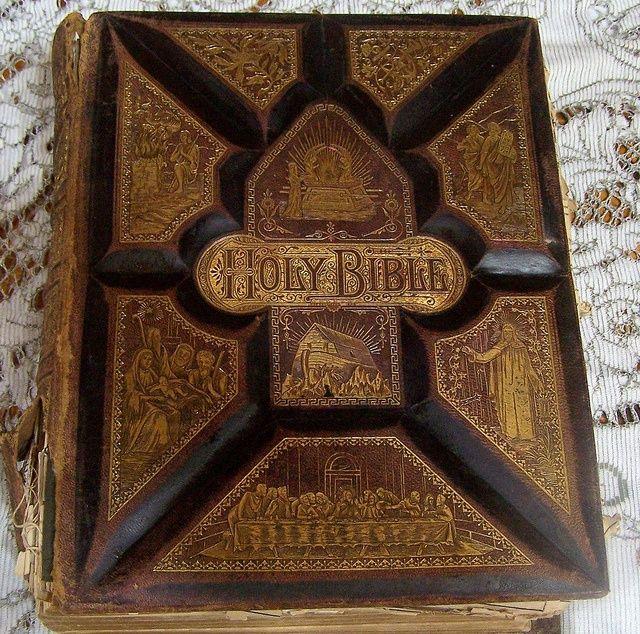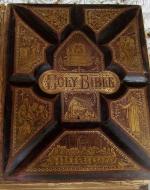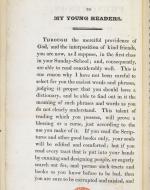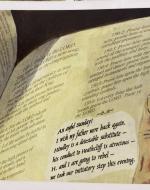Created by Ben Pool on Sat, 11/19/2022 - 22:33
Description:
A Victorian Bible from the 1860s.
Victorian England was a society shaped in many ways by Christian values and institutions. This gallery will explore some of the ways that the Christian Bible influenced the Brontё's lives and literature. It will begin with an exploration of the role the Bible played in the Brontё's actual lives, before delving into an examination of the ways that it influenced their literature.
Patrick Brontё's Address to Children, published in 1824
Patrick Brontё wrote his poem The Phenonemon with the intention that it would serve as a reward for children who did well in their Sunday School classes. In his preface to the poem, Brontё advises the reader: "if you read the scriptures and other good books only, your souls will be edified and comforted." Moreoever, he identifies the scriptures as "the finest specimens of beauty and sublimity in the world." Brontё's preface may provide insight into why exactly Brontё taught his children as much about scripture as he did. Seemingly, the Reverend believed not only that understanding scripture would provide guidance on proper living, but that the mere process of reading the inspired texts would enhance his childrens' moral fiber and bring them peace. This reverence for the process of reading itself might partially explain not just the Brontё''s tremendous scriptural fluency but their literary prowess as well.
Universal Reconciliation-An Angel Leading A Soul Into Hell by an unknown follower of Heironymus Bosch
Anne Brontё is rightly known as the most religious Brontё sister, but some of her religious views were very unorthodox. Namely, Brontё was an adherent of Universal Reconciliation, the idea that no-one was punished in Hell permanently, and that all sinners would eventually be reconcoiled to G-d. Brontё referenced reconcilitationist views in several of her writings. In Tenant of Wildfell Hall, for instance, when Helen Graham's Aunt Margaret tells her that Arthur Huntington will mostly likely be damned to Hell forever, Helen responds, "not for ever...He that 'is able to subdue all things to Himself, will have all men to be saved (A. Brontё 150).'"
Brontё's interest in Reconciliation may have stemmed in part from concern over the ultimate fate of her intemperate brother, Branwell. At any rate, Universal Reconciliation was a highly controversial theology in Victorian England, and understandly so, for the theology of eternal damnation was one of the main tools employed by the Church of England in encouraging Christian behavior (as the plethora of fire-and-brimstone Christians in the Brontё's novel attests).
Biblical Adultery-A Stained Glass Window depicting Moses and the Ten Commandments, from the Holy Trinity Cathedral in Addis Ababa, Ethiopa, constructed in 1942
In Tenant of Wildfell Hall, Helen Graham falls in love with Gilbert Markham, but is unwilling to establish a romantic relationship because of her marriage to Arthur Huntington—a marriage which seems to exist in name only. Similiary, in Jane Eyre, Jane refuses to be with Mr. Rochester when she discovers his marriage to Bertha Mason—like Helen's, a marriage apparently only in name. Both character's utter refusal to commit the most technical of adulteries, even in the face of terrible emotional turmoil, may strike the reader as strange if they are not aware of the Biblical conceptions of marriage and adultery in which those attitudes were rooted.
The legal foundation of a marriage, in the traditional Christian view, was derived not from the institutions and ordinances of humanity, but from the will of G-d. Thus, the New Testament refers to a married couple as what "[G-d] has joined together" (Mark 10:9). To violate the marital contract, even one which neither the husband or the wife was interested in sustaining, was therefore to violate a G-d-given covenant. Nor was this violation some minor sin—the prohibition on adultery comprises one of the Ten Commandments which collectively were understood as emunerating the basic moral framework of the Christian faith. Indeed, so grave was the sin of adultery that the Pentetuech proscribed it on pain of death (normative Christianity did not uphold this law as authoritative; it was understood, nonetheless, as revealed by G-d).
Catherine Linton's Bible-Wuthering Heights The Graphic Novel, artwork by John M. Burns, published on December 6th 2011
Catherine Linton's Bible scrawlings reveal a defining part of Catherine's personality, her self-centeredness. This trait is evidenced later on in the book when Linton abuses Nelly, or else when she refuses to pick between Edgar and Heathcliff, but it is first displayed, in almost momentous fashion, when her Bible is discovered. To a Christian Victorian audience, Linton's casual and disrespectul treatment of the Bible would have spoken volumes about her character, for the Bible was humanity's earthly link to the Divine. There was no greater authority she could have phsycially profaned.
Besides revealing her personal selfishness, Linton's scrawlings speak to her place within the mad domain of Wuthering Heights, an almost hellish place utterly void of authentic Christian values (as Emily Brontё seems to define them). Linton is a woman stuck between the passive world of Thrushcross Grange and the passionate world of Wuthering Heights, and her authentic connection to the latter is first revealed through Lockwood's discovery of the desecrated Bible.






